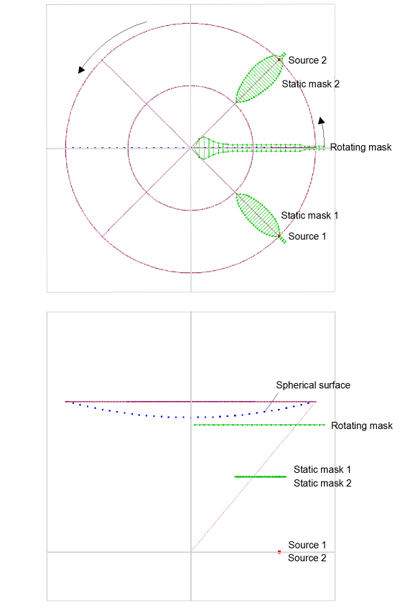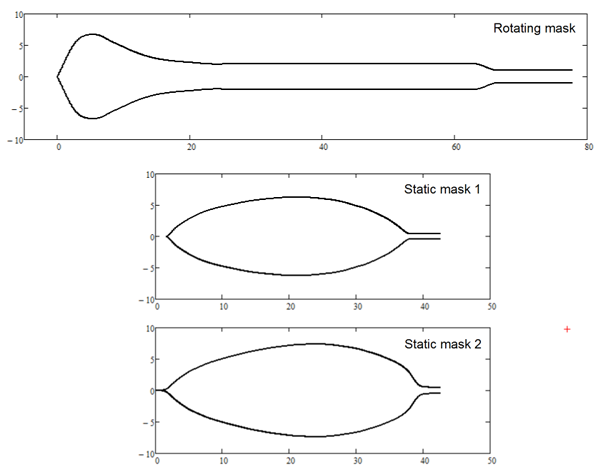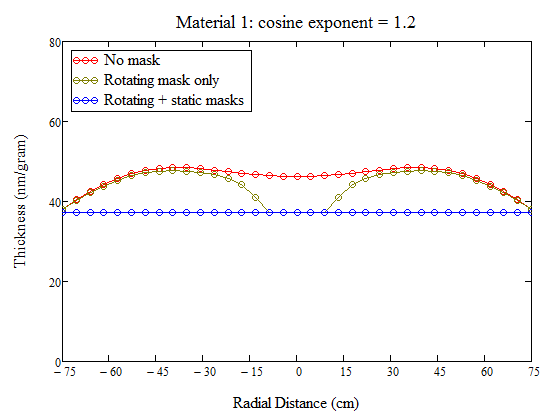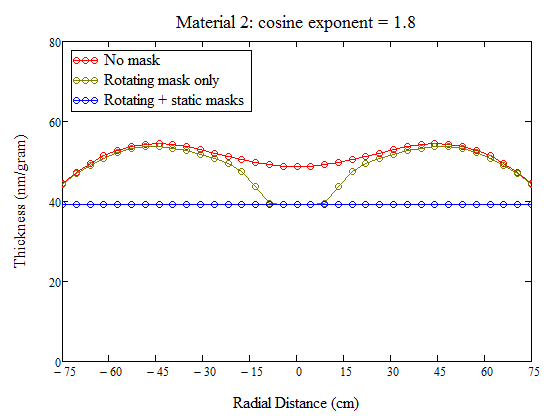Newsletter issued in February 2019
Correction Masks: Rotating or Static?
In coating of large-size optics, a combination of rotating and static masks can help in achieving important objectives, including thickness uniformity, process stability and ease of manufacturing.
A rotating mask is needed in coating processes where a substrate undergoes a simple rotation WHILE there is excess thickness near the rotation center. It is easy to appreciate that a static mask would either constantly shadow the center of the substrate (where the rotation axis intercepts the substrate) or cause no shadow at all, if the material vapor emanates from a point-like source. Although this is a mathematical anomaly under the assumption that the source is a point, it indicates that using a static mask to reduce thickness near the rotation center will be very unstable.
Fashioning a rotating mask for a coating process can be daunting. A rotating mask alone can rarely yield good thickness uniformity across a large radius - static masks typically accompany a rotating mask. The task of mask design is more difficult if the substrate is non-flat and multiple layers of different materials, which produce different vapor plumes, are to be deposited.
As an example, the diagram below shows a coating arrangement for a convex and spherical surface of 150 cm in diameter. Two different materials, which produce different vapor plumes through evaporation, are to be deposited. Two evaporation devices are located in Source 1 and Source 2 positions. A rotating mask is employed to cut down the excess thickness near the center of the spherical surface, while two static masks, shaped differently, are above the two source positions, respectively. The azimuth positions and height of the static masks are chosen such that they are uncoupled: Static mask 1(2) cast shadow of material vapor emitted from Source 1(2) only. (Please view a discussion on coupled and uncoupled correction masks in "Get the most out of your PVD coaters.") In this arrangement, vapor emitted from Source 1 is affected by the rotating mask and Static mask 1; vapor emitted from Source 2 is affected by the rotating mask and Static mask 2.
Even with the judicious arrangement shown above, determining the actual shapes and placement of the masks remains a hard task. Here, numerical modeling proves an effective approach. V-Grade 5S, a PVD modeling software suite (Tin Model LLC) is employed for the task. The following shows the shapes of the three masks that are designed and optimized with the help of V-Grade 5S. All the three masks have smooth varying edges, which promote process stability and are easy to manufacture. These masks all have provisions for installation: the mounting handles are included in the modeling and in the optimization process. Static mask 1 and 2 are optimized for two materials that possess powers 1.2 and 1.8 of the cosine, which characterize the vapor plumes, respectively.
Because Static mask 1 and 2 are uncoupled, there is no need to change masks: one material is evaporated from Source 1 position and the other from Source 2 position, without any interruption. The following plots show the thickness distributions of the two materials on the spherical surface under three conditions: no mask, with rotating mask only, and with rotating and static masks. With the optimized static masks, the thickness distributions are very uniform for both materials: the peak-to-valley non-uniformity of material 1 and 2 are +/-0.12% and +/-0.10%, respectively.
The example given here is just one of many possible arrangements in achieving good thickness uniformity for this coating job. V-Grade 5S is extremely flexible and versatile - you can experiment with your creative ideas and trust the predictions of the software. V-Grade 5S features advanced functions for mask design and optimization: you can easily test any mask design in a numerical trial-and-error process, or you can let the automated mask optimizer to optimize the masks for you. For each mask design, the program also tells you a number of important statistics, including vapor-collection efficiency, histogram of vapor incident angle on any given position of the substrate. Once a mask set is optimized, the software allows you to export mask design files for manufacturing.
Fitting masks for processes involving planetary rotations of substrates or sputtering sources can be equally difficult without numerical aid. V-Grade 5S series products offer a complete set of tools that allows you to derive a "perfect" set of correction masks for every job at hand. Please contact us or visit our website, www.tinmodel.com for detailed product information.
© 2019 Tin Model LLC, 2285 Massachusetts Ave.
Cambridge, Massachusetts 02140, U.S.A.
Phone: (857)498-9723
www.tinmodel.com




